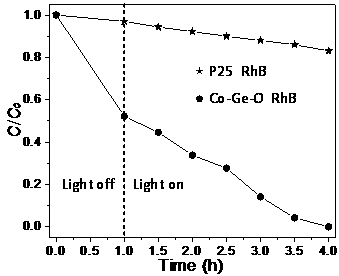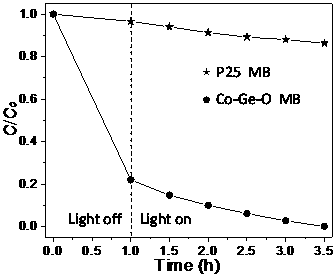Application of Co-Ge-O photocatalysis-adsorption bifunctional material
A dual-functional material and photocatalytic technology, applied in the field of environmental pollution control, can solve problems such as low adsorption capacity and low catalytic activity of visible light, achieve the effect of improving activity, solving low activity, and facilitating popularization and application
- Summary
- Abstract
- Description
- Claims
- Application Information
AI Technical Summary
Problems solved by technology
Method used
Image
Examples
Embodiment 1
[0020] (1) Preparation of Co-Ge-O material
[0021] Dissolve 0.06 g of NaOH (1.5 mmol) in 30 mL of deionized water, and then take 0.11 g (1 mmol) of GeO 2 In the above NaOH solution, after stirring until the solution is clear, add 0.58 g (2 mmol) of Co(NO 3 ) 2 ·6H 2 O. After stirring for 10 minutes, it was transferred into a polytetrafluoroethylene reactor with a volume of 40 mL, and stood at 180°C for 6 hours. Cool naturally, centrifuge, wash with deionized water three times, and dry at 60°C for 10 h to obtain samples.
[0022] (2) Characterization of Co-Ge-O materials
[0023] Depend on figure 1 The EDS element analysis results of the SEM images in the middle show that the Co-Ge-O sample contains Co, Ge and O elements, indicating that Co-Ge-O was successfully prepared.
[0024] (3) Co-Ge-O material adsorption-photocatalytic degradation activity evaluation of RhB and MB dye pollutants
[0025] The obtained Co-Ge-O samples were respectively used RhB and MB as degradat...
PUM
| Property | Measurement | Unit |
|---|---|---|
| wavelength | aaaaa | aaaaa |
Abstract
Description
Claims
Application Information
 Login to View More
Login to View More - R&D
- Intellectual Property
- Life Sciences
- Materials
- Tech Scout
- Unparalleled Data Quality
- Higher Quality Content
- 60% Fewer Hallucinations
Browse by: Latest US Patents, China's latest patents, Technical Efficacy Thesaurus, Application Domain, Technology Topic, Popular Technical Reports.
© 2025 PatSnap. All rights reserved.Legal|Privacy policy|Modern Slavery Act Transparency Statement|Sitemap|About US| Contact US: help@patsnap.com



